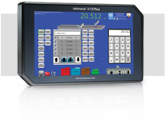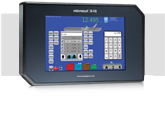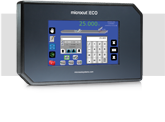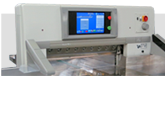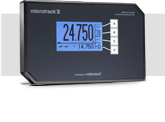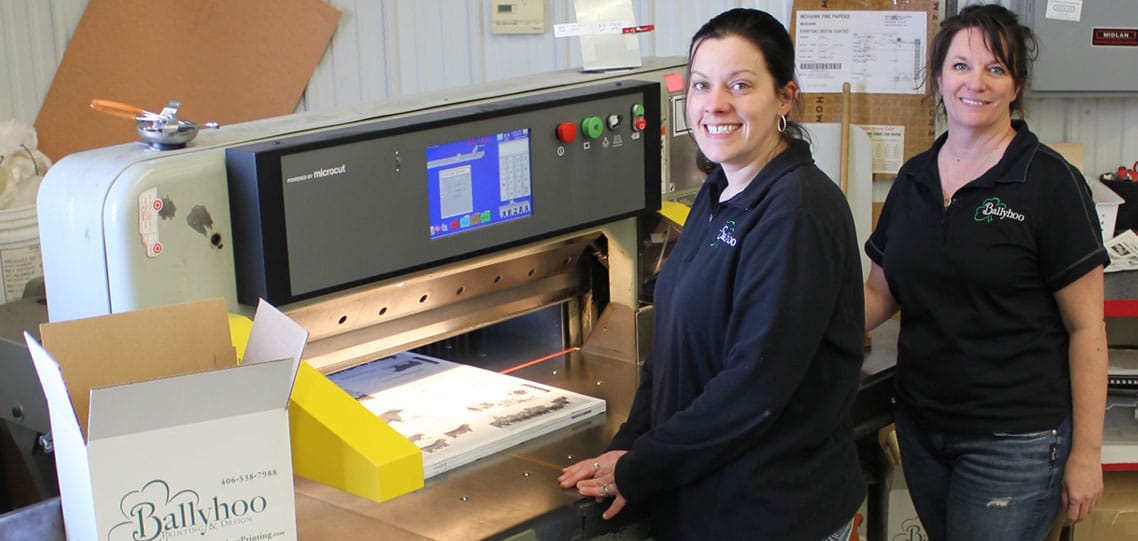After growing up on a ranch, Gerri Campbell knows that life on the range can be a challenge at times. She’s the owner of Ballyhoo Printing & Design in Lewistown, Montana, a small commercial print shop she and her ex-husband bought in 2000.
A lightning strike in late June posed a threat to her business after frying the electronics on her 36-inch Polar paper cutter. But a complete retrofit of the paper cutter, performed by Colter & Peterson with an all-new Microcut computer controls package, put the business back on track for one of their busiest times of the year.
“We have an older Challenge paper cutter that is strictly our back-up machine. It was original equipment when we bought the shop and the gentleman we bought the business from was very traditional,” Campbell recalled. “He would not teach me how to change the blade because he thought some things women shouldn’t do.”
Getting the Polar up and running again was a top priority. Campbell had purchased the four-year-old machine from the owner of a print shop 200 miles away who was going out of business. Her insurance company first asked if renting was an option before clearing the way.
“This was my first time dealing with Colter & Peterson,” she said. “I did a Google search and their name popped up right away. I had checked with Heidelberg for repair options, but C&P was the most economical way to go. I have absolutely no regrets.”
Technician Derek Baldwin got the go-ahead to fly up from Colter & Peterson’s west coast office in Petaluma, California, and started the process on August 12. He and local mechanic Dave Bennyhoff, spent the better part of three days taking the machine apart, installing and fine tuning Microcut, and training Campbell and her five full-time employees. Each one knows how to run the paper cutters.
“It was quite an upgrade and a good option for us. The guys did a quick overview because the machine now is so intuitive,” remarked Campbell. “We are familiar with the capabilities since we put Microcut on the Challenge 10 years ago. But with the new package, it is two different worlds. The Polar is so much faster.”
Fulfilling the needs of a demanding market
Ballyhoo has a unique market niche since Campbell has remained connected to the agricultural and registered cattle world she grew up with. Her father was the marketing director for the Stevenson Basin ranches and then his own ranch, Shamrock Angus. The shop designs, prints and mails catalogs for registered cattle sales that are held throughout the U.S. every spring and fall.
“When we bought the print shop, our son was three months old,” says Campbell of her 19-year-old. She also has a 24-year-old daughter. “It was the work ethic and experience of our agricultural world that has made this business successful. That connection keeps us fully aware of our customers and their needs. We have worked with several ranches for all of our 20 years.”
Located about 125 miles northwest of Billings, Ballyhoo started printing the catalogs for the Stevenson family bull and female sales and reference editions in 2002. Most ranches catalog several hundred animals; Stevenson’s Diamond Dot sells over 1400 head each fall that requires a 100 page perfect bound book.
The Midland Bull Test, which accepts 800 purebred bulls from over 200 consignors representing 32 states, prints a 120 page perfect bound catalog in addition to their entry forms and three test reports every year. Most catalogs are saddle stitched with quantities ranging from less than 100 to more than 3000, depending on the number of head being sold.
Accuracy and consistency with Microcut programming
“As a commercial shop, we do our share of business cards, invoices and photo printing for retail customers. But we do sales catalogs for 100 different ranches across the country, mostly Angus cattle,” said Campbell, who is impressed with the Polar’s upgraded benefits.
“I like its programming capabilities. Now we can name our projects and set cuts, and not just assign a number. It also does the math for you. Sales catalogs are primarily 8-1/2 by 11 inches when finished. We are still getting used to the little things it does. It gives us the ability to make thick cuts when necessary and we’ve only had to change the blade once.”
Campbell said she likes the accuracy – within 1/64th of an inch – and consistency of the Polar’s cutting. It’s important since the shop annually uses more than 650,000 sheets of paper for the sales catalogs. The paper cutter also works well with the Stahl bindery equipment she uses for the catalogs.
“Our main press is a Heidelberg MO and we have a couple of duplicators as well,” says Campbell, indicating that offset accounts for 80 percent of the work. But she acknowledges that interest in digital printing with her customers is growing.
“We recently added a Xerox V180 press since we are doing more digital printing, especially smaller catalogs and short run jobs. We are very rural and strive to find how we can best serve our community. Digital gives our customers more options. Having the Polar be as fast as it is now with Microcut gives us more options to manage and turn the work quicker and keep those customers satisfied.”


